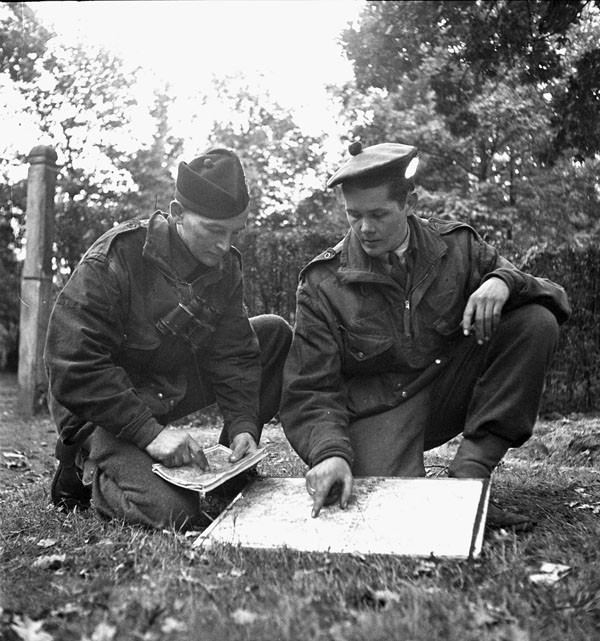By this time, the German defence had retreated behind the canal. As the Canadians slowly advanced through the flooded terrain to the east of the canal, the Germans blew up all the bridges and dug themselves in. The defence in Wemeldinge was particularly strong because the flooding in that area was less extensive, making it likely that a crossing over the canal would be attempted.
On Friday morning at 10:30 a.m., Major Gagnon gathered his officers at the battalion headquarters in Yerseke to discuss an assault plan. They decided to cross the canal via the Bonzijweg in Wemeldinge. The remnants of the blown-up bridge were reported to be passable on foot, according to scouts who had recently visited the canal bank.
After the meeting, two companies set off for the canal, but as evening approached, they decided to abandon their mission. The German defence had been well-prepared, and the mortar and artillery fire impeded the Canadians to such an extent that they could not get close enough to the bridge to attempt a crossing. Major Gagnon ordered a retreat and instructed his troops to take up positions along the canal dyke. This would allow a third company to attempt to cross the canal further north at the locks using boats. By this time, two men had been killed and six wounded as a result of enemy fire.
After the rowing boats arrived, the second attack began on Friday evening at 9:00 p.m. In this area, the German defence was also well-prepared. Once the vanguard reached the locks, intense fire broke out. In the heat of battle, Lieutenant Hailey was killed, becoming a victim of enemy machine-gun fire. Nine out of ten boats sank, leading to the decision to evacuate the remaining soldiers from the sluice plateau with the last boat. The troops who were concealed behind the canal dyke were unable to intervene, as the dyke was constantly under enemy fire. It wasn’t until Saturday morning at 8:58 a.m. that all Canadian soldiers had retreated. "We are meeting exceptional opposition," reported Major Gagnon to brigade headquarters.
On Saturday, the Allied Air Force was called in to bombard Wemeldinge. Around 1:00 p.m., the Typhoons arrived. While the German defenders were preoccupied with the bombs and rockets from the Royal Air Force, Lieutenant Tupper and six scouts from the battalion managed to cross the canal at the locks. They were followed by a combat patrol commanded by Lieutenant Murray. By this time, the Typhoons had returned to base, allowing the stubborn Germans to open fire on Lieutenant Murray and his men with all the weapons at their disposal. Murray quickly withdrew. To make matters worse, the German artillery opened fire on the Canadian positions on the eastern bank of the canal. Within an hour, 160 shells exploded among the Canadian foxholes, resulting in nine fatalities among the Canadians.
Meanwhile, other Canadian troops had successfully crossed the South Beveland Canal near Vlake. In light of this development, the Camerons were ordered to cease their attack at Wemeldinge. Their only remaining task was to prevent the Germans from destroying the locks.
To overcome the determined German defence in Wemeldinge, the Essex Scottish Regiment was commanded to leave Vlake and advance northward along the left bank of the canal. Following this manoeuvre, the soldiers of the Queen’s Own Cameron Highlanders were able to cross the canal without resistance at 10:30 a.m. The Camerons were the first to reach the canal but were the last battalion of the brigade to make it to the other side.
